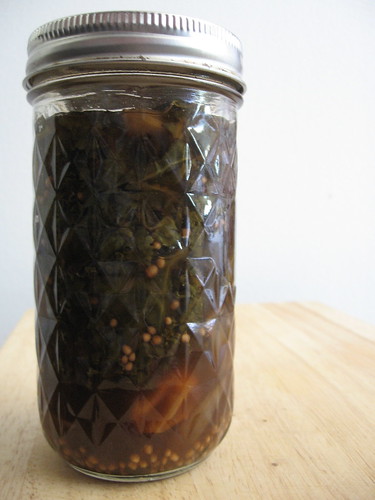Kale is one of my go-to winter vegetables. It's delicious braised or sautéed, in soups or gratin, and I'm shocked to see that I have not put a single kale recipe on this site.
I suppose I shouldn't be surprised. It's not the most photogenic of foods, and for me, at least, kale tends to find itself sautéed, perhaps seasoned with garlic and herbs or soy sauce and sesame, and relegated to the oft-forgotten category of side vegetable.

And this is no exception, but it is, at least, a little bit more unusual. Pickled kale.
You heard me right. When I was flipping through Liana's fantastic cookbook late last fall, I saw those words and nearly ran to buy new canning jars that minute. Kale is available nearly year-round here, but I made these in mid-fall, when it seemed to be overgrowing all the farmers' fields. Since appearances aren't so important for a humble pickle, late season kale would also be ideal; just snatch it up before the weather gets too warm, because that's when it starts to be bitter.

Now, if you're anything like Mike, my sister, or anybody else that I told about this recipe, you're probably wondering what the heck you might do with pickled kale. I wasn't sure myself when I made it. Liana suggests serving it stirred into Jamaican rice and peas (still on my list) or on a sandwich. My first thought was to pair the zing and little bit of spice with pastrami.
It was a revelation. A smear of spicy dijon mustard, several slices of pastrami and Swiss cheese, and a generous layer of pickled kale slapped between two slices of rye bread, and we ate almost an entire jar (half-pint, in our defense) of pickles with one meal. Since then I've also experimented with a meatless version—grilled Swiss on rye with mustard & kale pickles—and it's just as good.

Spicy Pickled Kale
Adapted from Canning for a New Generation
Note: Liana's recipe called for 7 cups cider vinegar and 1 cup balsamic, but I was running out of cider vinegar (and using a bit less kale) and so changed the amounts.
two big or 3 smaller bunches of curly kale (I had 3.5 pounds total)
3 tablespoons yellow mustard seeds
1 tablespoon whole allspice
1 tablespoon green cardamom pods, lightly crushed
3 cups apple cider vinegar
3 ½ cups white vinegar
½ cup balsamic vinegar
1 cup water
2 tablespoons kosher salt
2 tablespoons sugar
3 large or six small habañero chiles
6 cloves garlic
1 small onion, cut into 12 wedges
Wash the greens, then pull the leaves off of the hard ribs. Discard the ribs and stems or keep for another use. Chop the kale into medium chunks then shake off most of the water (the cookbook recommends putting them in an old pillowcase and shaking it outside. I just used the salad spinner in batches).
Combine the mustard seeds, allspice, and cardamom in a small bowl; set aside.
To prep for canning, heat water in a large canning pot; wash the jars and keep them in the pot, and put the lids in a small heatproof pot or bowl.
Combine the vinegars and water with the salt or sugar and bring just to a boil; cover, remove from heat, and set aside.
Ladle boiling water from the canning pot into the bowl with the lids. Remove the jars from the canning pot (returning the water to the pot) and carefully place them on a towel.
Halve the chiles, if you have large ones. Place one chile or chile half, one garlic clove, and a wedge or two of onion in each jar. Pack the greens into the jars (tightly, as they will shrink when processing). Distribute the spices into the jars as well. Carefully ladle the hot vinegar mixture into the jars, using a chopstick as needed to remove air bubbles, and leaving ½ inch headspace.
Put the lids on the jars and screw rings on just finger-tight. Return the jars to the canning pot and process at a full boil for 15 minutes. Remove the jars to the folded towel and let rest overnight. (Check them after an hour or so to make sure they have sealed; if not, transfer to the fridge.)
Makes about 6 pints

No comments :
Post a Comment